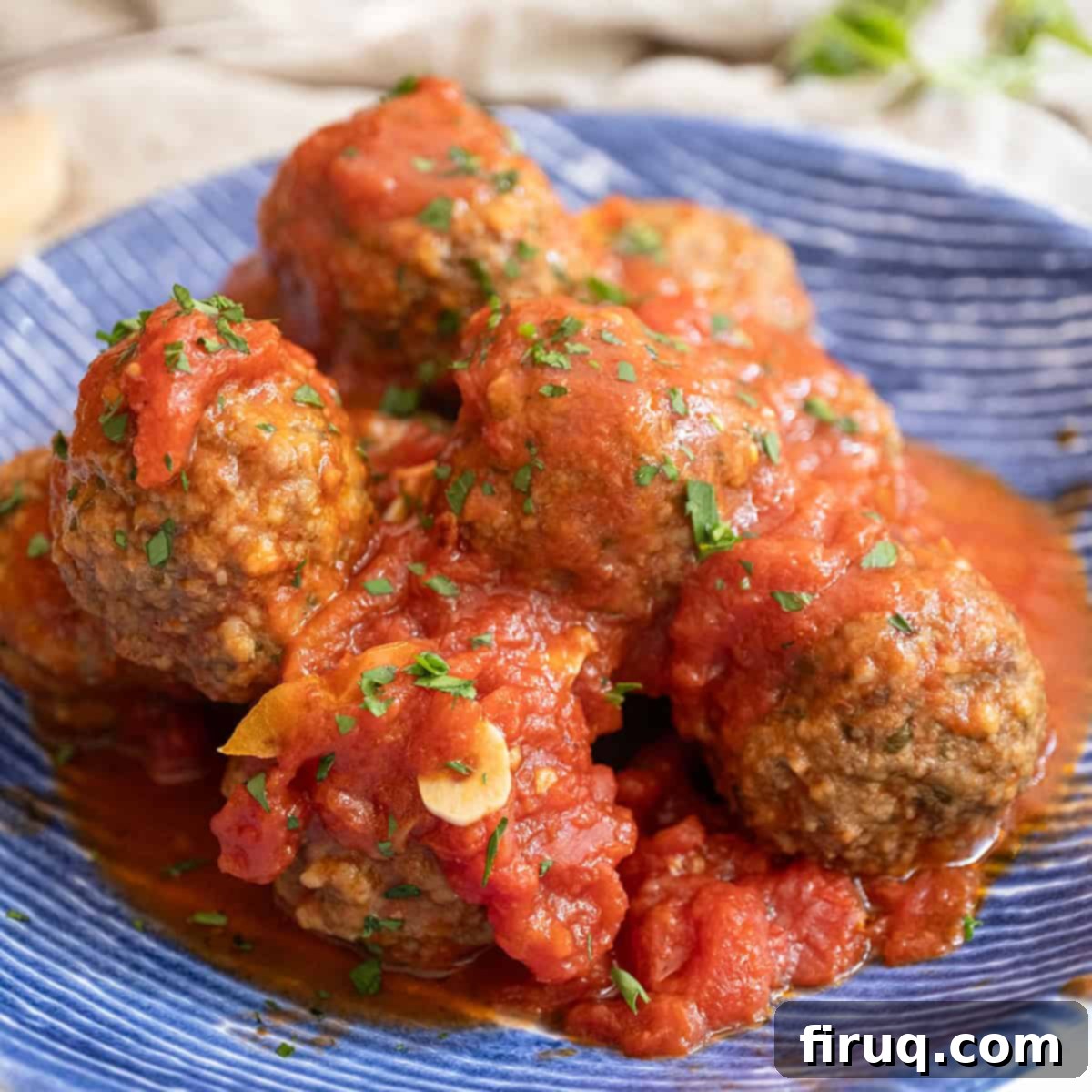Classic Fried Italian Meatballs in Rich Tomato Sauce: Your Nonna’s Recipe
There’s nothing quite like the comforting aroma of homemade Italian meatballs simmering in a rich, slow-cooked tomato sauce. These Classic Fried Italian Meatballs are not just a meal; they’re a tradition, a taste of heritage, and a culinary hug from your grandmother’s kitchen. Crafted with simple yet powerful ingredients like savory ground beef, authentic Parmigiano cheese, fresh parsley, and aromatic garlic, these meatballs are guaranteed to be flavorful, incredibly moist, and wonderfully tender. They are the perfect centerpiece for any pasta dish or a star addition to your cherished Sunday Sauce.
These versatile beef meatballs are designed to absorb the vibrant flavors of a long-simmered Sunday Sauce, making them melt-in-your-mouth delicious. Beyond pairing them with a simple spaghetti, they’re also fantastic served on the side of dishes like Pasta alla Norma (A Sicilian Dish), making any meal feel truly special and authentically Italian-American.
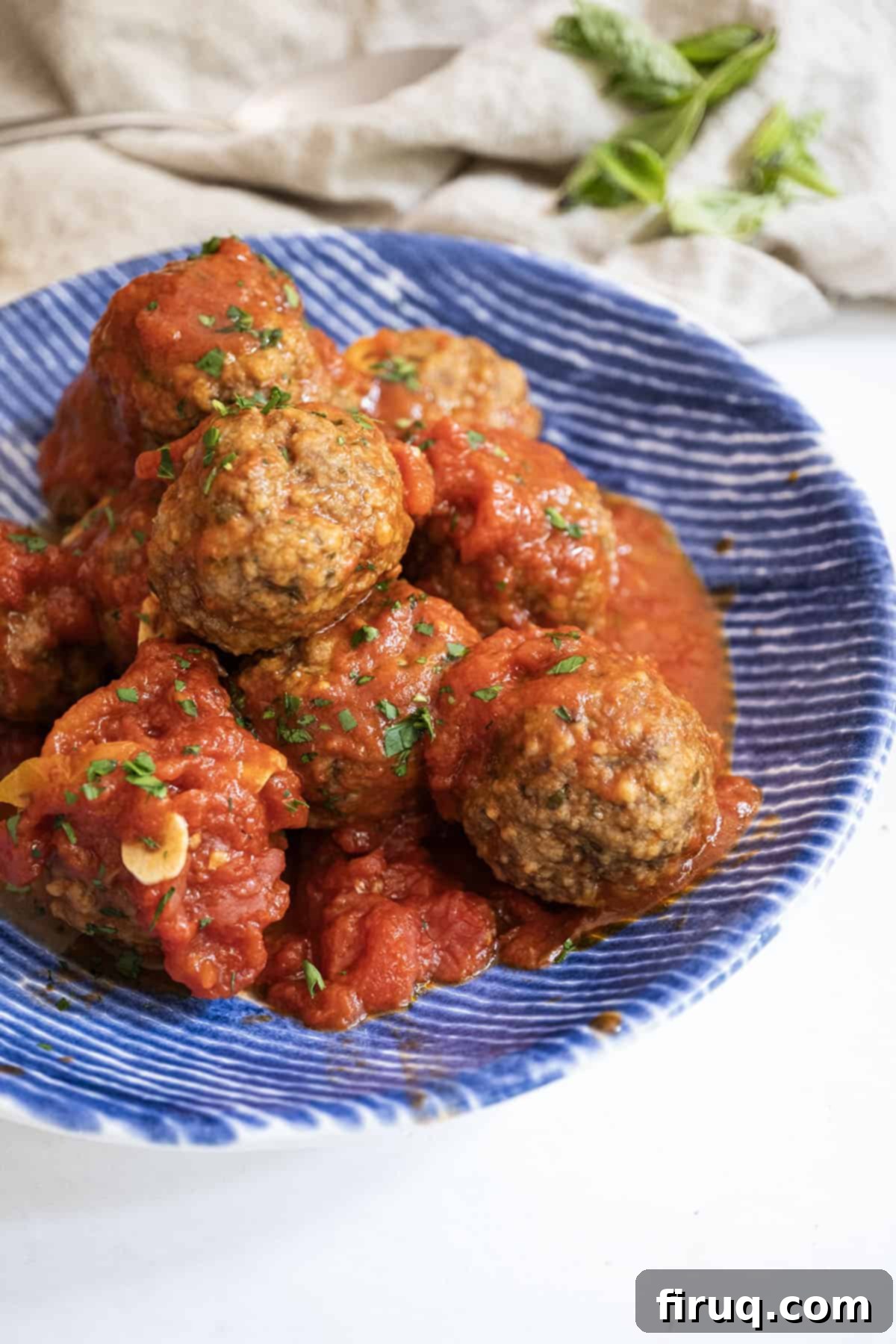
Craving more hearty and authentic Italian Sunday Meals? Don’t miss our indulgent Bison Ragu or the rich and traditional Authentic Bolognese.
Why Frying is the Secret to Unforgettable Italian Meatballs
The culinary landscape of Italian-American cooking is rich with regional and familial variations, especially when it comes to beloved dishes like meatballs. From the choice of meat—be it pure beef, a classic beef-pork blend, or the trifecta of beef, pork, and veal—to the debate over fresh bread versus dried breadcrumbs, and even fresh garlic versus garlic powder, every Nonna has her signature touch. However, one of the most significant and passionately debated differences lies in the cooking method: do you bake, fry, or (heaven forbid, some might say) cook them raw directly in the sauce?
While some adventurous cooks might drop raw meatballs straight into their simmering sauce, a method more commonly seen in dishes like Italian Wedding Soup, for truly authentic fried Italian meatballs, this approach is often met with raised eyebrows from purists. The key differences between baking and frying meatballs ultimately come down to the exquisite interplay of texture and flavor.
When you take the time to fry your meatballs, you’re not just cooking them; you’re transforming them. The high heat of the oil creates a beautiful, golden-brown crust on the exterior of each meatball. This crust is more than just visually appealing; it locks in moisture, enhances the savory notes of the meat, and, crucially, develops an intensely complex flavor. This seared exterior then interacts with your tomato sauce, enriching it with savory browned bits and intensifying the overall depth of flavor in a way that simply cannot be achieved otherwise. It’s this distinctive sear that defines the true taste of traditional Italian Fried Meatballs.
Conversely, baking meatballs will yield a different, though still delicious, result. Baked meatballs tend to be much softer and more tender throughout, lacking that signature exterior crust. While this can be a perfectly enjoyable texture, it doesn’t offer the same depth of flavor or the satisfying bite that comes from frying. From a health perspective, baking might be seen as a lighter option due to less added fat, but many argue that the sacrifice in flavor and texture isn’t worth it for a truly authentic experience.
Ultimately, the choice is yours, and it often boils down to preference and practicality. I personally advocate for and prefer the rich flavor and textural contrast of fried meatballs. However, I understand that sometimes efficiency wins out. If I’m preparing a feast for a large crowd, I might opt to bake them to save valuable time. It’s considerably easier to bake a large batch alongside a pan of Authentic Italian Baked Ziti or Italian Stuffed Shells with Meat Sauce and Ricotta, rather than standing over the stovetop frying 30 meatballs in small batches. But for that true, cherished flavor, frying remains supreme.
Ingredient Notes and Expert Substitutions for Perfect Meatballs
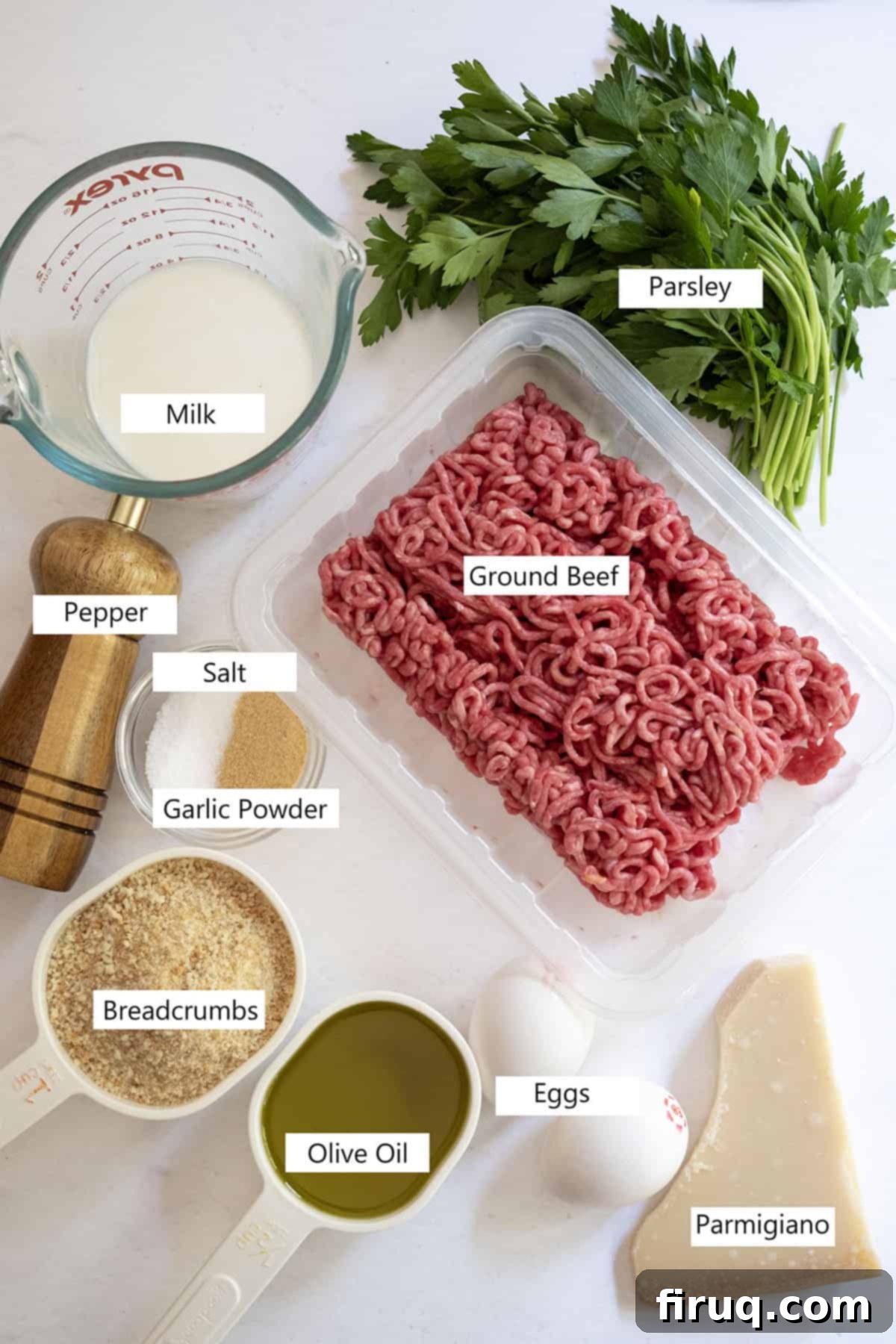
Every great dish starts with quality ingredients. Here’s what you need to know to ensure your meatballs are perfect:
- Ground Beef: For truly tender and moist meatballs, I highly recommend using 80% lean ground beef (80/20). The fat content is crucial here; anything leaner, and your meatballs risk becoming dry and tough. The fat melts during cooking, keeping the meatballs juicy and flavorful. For an even richer, more complex flavor profile, consider using a combination of meats: a classic blend is 50/50 beef and pork, or the traditional “holy trinity” of beef, pork, and veal for ultimate tenderness and depth.
- Parmigiano Cheese: This hard, salty Italian cheese adds a wonderful depth of umami and a subtle nuttiness that elevates the meatballs. While I prefer the nuanced flavor of genuine Parmigiano-Reggiano, you can certainly substitute with Pecorino Romano for a sharper, saltier kick. Ensure you use freshly grated cheese for the best flavor and texture; pre-grated varieties often contain anti-caking agents that can affect the consistency.
- Olive Oil: When frying meatballs, the quality of your oil matters. Opt for a good quality extra virgin olive oil. Not only does it impart a delicious flavor, but it’s also a healthier option compared to many processed oils. Olive oil has a smoke point of around 400°F (204°C), making it perfectly suitable for frying these meatballs without burning. For an extra touch, choose an olive oil sourced from a single type of olive.
- Breadcrumbs: Breadcrumbs are essential for binding the meat mixture and adding moisture. I grew up with my mom always using dried breadcrumbs, which are incredibly convenient to keep on hand. While some recipes call for cubed stale bread soaked in milk, dried breadcrumbs offer flexibility. If your meat mixture feels a little too wet, you can easily add a spoonful or two more breadcrumbs to achieve the right consistency.
- Garlic Powder: For meatballs that will be fried, I always recommend using garlic powder instead of fresh garlic. The reason is simple: garlic powder disperses more evenly throughout the meat, ensuring consistent flavor in every bite, and it’s far less prone to burning during the frying process, which can lead to a bitter taste. Save your fresh garlic for sautéing in the sauce!
- Whole Milk: The addition of milk is vital for keeping your meatballs tender and moist. Whole milk is best due to its higher fat content, which contributes to the overall richness and prevents the meatballs from becoming dense or dry. It helps to soften the breadcrumbs and bind the mixture gently.
- Eggs: Eggs act as an excellent binder, helping to hold the meatball mixture together and preventing them from falling apart during frying and simmering. They also add a bit of richness.
- Fresh Parsley: Chopped fresh parsley adds a vibrant herbaceous note and a touch of color that brightens the overall flavor of the meatballs.
- Kosher Salt & Black Pepper: Proper seasoning is paramount. Kosher salt provides a clean, even saltiness, and freshly ground black pepper adds a subtle warmth. Adjust to your taste!
Please see the recipe card below for precise measurements and detailed information about all ingredients.
How to Master Classic Italian Fried Meatballs
Making truly exceptional Italian fried meatballs is a two-part process that guarantees maximum flavor and tenderness. The initial cooking involves pan-frying to develop that irresistible crust, followed by a gentle simmer in a rich tomato sauce to infuse them with flavor and ensure they are incredibly moist. While you can cook the meatballs all the way through during the frying process, finishing them in sauce is the traditional and recommended method for the best results. For more on creating the perfect accompaniment, be sure to check out our Ultimate Guide to Marinara Sauce.
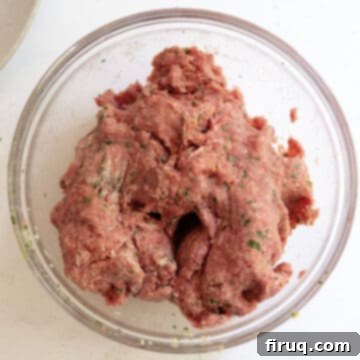
Step 1: Prepare the Meat Mixture. In a large mixing bowl, gently combine all of your meatball ingredients: ground beef, breadcrumbs, eggs, whole milk, chopped fresh parsley, grated Parmigiano cheese, garlic powder, and kosher salt. Use your hands to mix thoroughly until all ingredients are evenly distributed, but be careful not to overwork the meat. Overmixing can lead to tough, dense meatballs. The mixture should feel pliable but hold its shape. If it feels too wet, add a tablespoon of breadcrumbs at a time until it’s just a little tackier. If it seems too dry or grainy, a splash of extra milk will help.

Step 2: Shape the Meatballs. Using a 1/4 cup measure or a large cookie scoop, portion out the meat mixture. Roll each portion into a smooth, compact ball. Aim for consistently sized meatballs to ensure even cooking. This recipe should yield approximately 20-24 meatballs, perfect for a family meal or for freezing half for later. Place the rolled meatballs on a plate or baking sheet as you go.
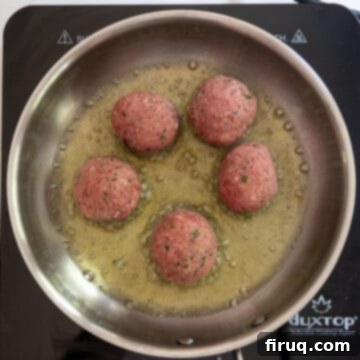
Step 3: Begin the Frying Process. Heat a large, heavy-bottomed pan (cast iron or stainless steel are ideal for getting a good sear) over medium heat. Pour in about 1/4 cup of olive oil, or enough to reach approximately half a fingernail’s depth in the pan. To test if the oil is hot enough, drop a tiny piece of breadcrumb into the oil; if it sizzles gently, it’s ready. Carefully place your meatballs into the hot oil, working in batches to avoid crowding the pan. Overcrowding will lower the oil temperature and prevent proper browning.
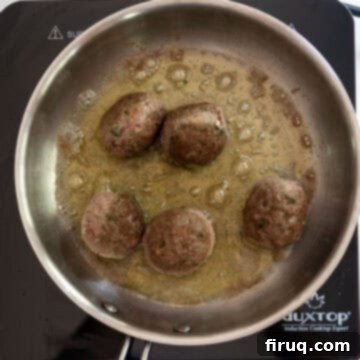
Step 4: Brown the Meatballs. Fry the meatballs for about 1 minute on each side, turning them gently with tongs, until they are beautifully browned all over. The goal here is to create that delicious crust, not necessarily to cook them through completely. If you prefer to skip the sauce simmering step, you can continue frying them until they reach an internal temperature of 165°F (74°C). However, for the ultimate Italian experience, I strongly recommend finishing them in a tomato sauce. Once browned, remove the meatballs from the pan and set them aside on a plate lined with paper towels to drain any excess oil.

Step 5: Start the Tomato Sauce. Using the same pan (or a large pot if your frying pan isn’t suitable for simmering sauce), add another tablespoon of olive oil. Add your thinly sliced fresh garlic and sauté gently for 1-2 minutes until fragrant. Be careful not to burn the garlic, as this will make it bitter. This step builds the foundational flavor for your sauce.

Step 6: Simmer the Sauce. Pour in a 28 oz can of high-quality crushed tomatoes. Alternatively, if you prefer a chunkier texture, you can hand-crush a can of whole plum tomatoes yourself for a more rustic feel. Stir in a handful of fresh basil and a teaspoon of salt (adjust to taste later). Bring the sauce to a gentle simmer over medium-low heat. Let it bubble lightly, allowing the flavors to meld and deepen.
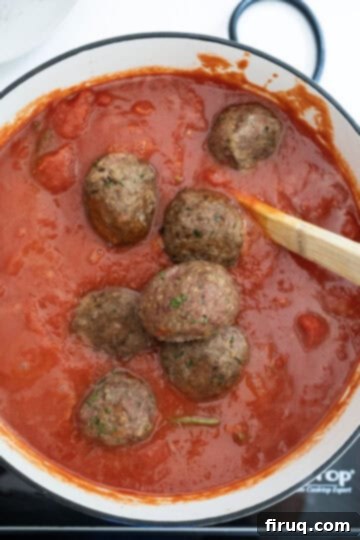
Step 7: Simmer Meatballs in Sauce. Once your sauce is gently simmering, carefully transfer the browned meatballs into the pot. Ensure they are mostly submerged in the sauce. Cover and allow them to simmer for at least 30 minutes. For truly fork-tender meatballs and a deeply flavored sauce, I recommend simmering for up to 2 hours, or even longer if it’s your Sunday sauce. The longer they simmer, the more the meatballs absorb the rich tomato flavors and become incredibly soft.
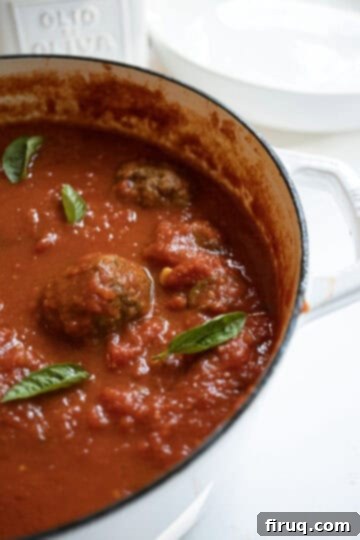
Step 8: Serve and Enjoy. Once the meatballs have reached your desired tenderness, remove them from the sauce and arrange them on a serving platter. The remaining sauce in the pot is now perfectly infused with meatball flavor and is ideal for tossing with your favorite pasta. Garnish with a sprinkle of fresh Parmigiano-Reggiano and a few basil leaves, and prepare to enjoy a truly authentic Italian meal.
Pro-Tips for Your Best Italian Meatballs
- Choose the Right Pan for Frying: For achieving that perfect, flavor-rich crust on your meatballs, I strongly recommend using a cast iron pan or a stainless steel pan for frying. These materials retain heat incredibly well and provide an excellent surface for searing. It is crucial to avoid using a non-stick pan here, as non-stick surfaces prevent the browning and crust development that is essential for the signature flavor of fried Italian meatballs. The even heat distribution of cast iron and stainless steel ensures all your meatballs cook evenly and develop that desirable golden-brown exterior.
- Proper Oil Depth and Temperature: The amount of oil can vary slightly based on your pan’s size, but a good rule of thumb is to have the olive oil about half a fingernail deep in the pan. To ensure the oil is hot enough before you start frying, you can drop a tiny piece of breadcrumb into it; if it immediately sizzles and floats, your oil is ready. Frying at the correct temperature (medium heat) is vital to create a crust without burning the exterior or leaving the interior raw.
- The Magic of Slow Simmering: When I make meatballs, they’re almost always destined for a glorious Sunday sauce, where they’ll simmer for 2-3 hours. This extended simmering time is not just for cooking; it’s for infusing every fiber of the meatball with the rich flavors of the tomato sauce. The longer you simmer them, the softer and more tender they will become, absorbing all that deliciousness.
- Do Not Overwork the Meat: This is a golden rule for meatballs. When combining your ingredients, mix just until everything is incorporated. The more you mix the meat, the more the protein strands develop, leading to a denser, tougher meatball. Gentle handling ensures a light, tender texture.
- Room Temperature Ingredients: Allowing your ground beef and eggs to come to room temperature before mixing can help them combine more easily and result in a more uniform, tender meatball texture.
- Test a Small Patty: Before rolling all your meatballs, fry a tiny patty of the mixture. This allows you to taste and adjust the seasoning (salt, pepper, garlic powder) before committing to the whole batch.
- Chill for Easier Handling: If your meat mixture feels too soft to roll easily, cover it and refrigerate it for 20-30 minutes. This will firm it up, making the rolling process much smoother.
- Don’t Crowd the Pan: Frying in batches is crucial. Overcrowding cools down the oil, resulting in steamed rather than seared meatballs, preventing that desirable crust from forming. Give each meatball space to breathe and brown properly.
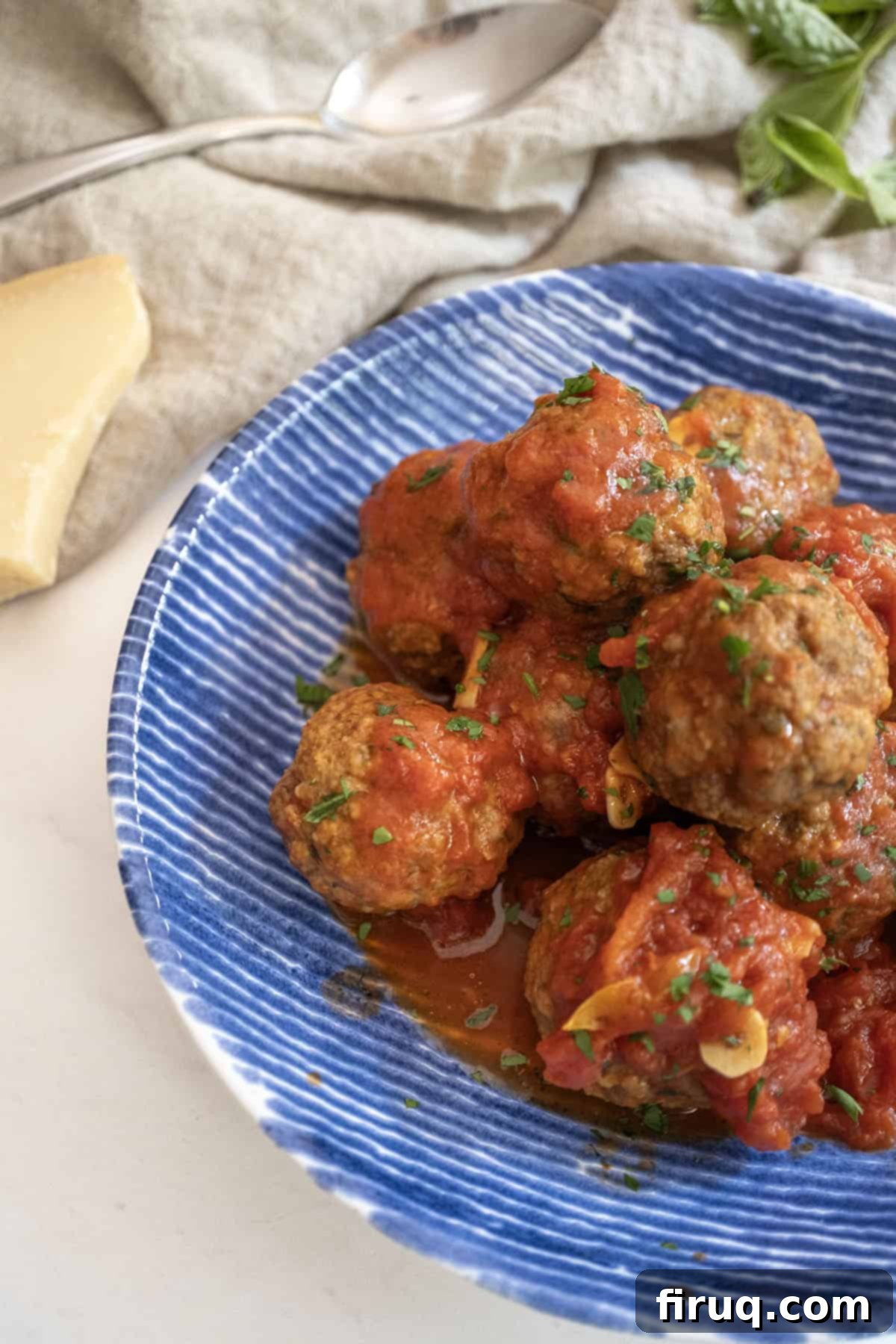
Recipe FAQs: Your Meatball Questions Answered
You absolutely can bake them, and many people do for convenience or a lighter option. The primary difference, however, is that you won’t achieve the rich, browned crust and intense flavor that comes from pan-frying. Baking typically yields a softer, more uniformly cooked meatball. If you choose to bake, preheat your oven to 350°F (175°C) and bake the meatballs for approximately 15-20 minutes, or until they are cooked through and reach an internal temperature of 165°F (74°C). While a healthier alternative, be prepared for a subtle trade-off in the depth of flavor that frying provides.
Yes, and I highly recommend it for meal prepping! I often double the recipe specifically for freezing. There are two main ways to freeze them:
- After Frying (Recommended): Fry the meatballs according to steps 1-4 of the recipe, letting them brown and develop that crust but not necessarily cooking them through. Allow them to cool completely. Once cooled, place them in a single layer on a baking sheet and freeze for about an hour until solid. Transfer the frozen meatballs to a freezer-safe ziplock bag or airtight container. They will stay fresh in the freezer for up to 6 months. When ready to use, you can drop them directly into simmering tomato sauce (they’ll cook through as they simmer) or thaw them first.
- Raw: You can also freeze raw, rolled meatballs. Place them on a baking sheet lined with parchment paper and freeze until solid. Then transfer to a freezer-safe bag. Thaw them in the refrigerator overnight before frying or baking.
Absolutely! Meatballs are a fantastic make-ahead dish, which makes meal planning so much easier.
- Meat Mixture: You can prepare the meat mixture a day in advance, cover it tightly, and store it in the refrigerator. Roll the meatballs just before frying.
- Rolled Meatballs: Roll out all the meatballs and arrange them on a plate or baking sheet, cover them, and refrigerate for up to 24 hours before frying.
- Fried Meatballs: Fry the meatballs until browned, let them cool, and then store them in an airtight container in the fridge for 2-3 days. When ready to serve, simply add them to your simmering tomato sauce and heat through until piping hot. This method is perfect for getting ahead on your Sunday sauce prep!
What to Serve with Your Perfect Italian Meatballs
The beauty of classic Italian meatballs is their incredible versatility. While they shine brightest alongside a simple pasta dish, the possibilities for pairing them are truly limitless. Here are some of my favorite ways to enjoy these tender, flavorful morsels:
- The Ultimate Sunday Supper: Serve these meatballs as a cornerstone of a traditional Sunday sauce, alongside other slow-cooked meats like Homemade Italian Sausage, elegant Authentic Italian Braciole, and even flavorful neck bones. This creates a feast that’s rich in flavor and tradition.
- Classic Sandwiches and Beyond: Transform leftovers (or fresh batches!) into a mouthwatering meatball parm sandwich, piled high on crusty bread with melted mozzarella and extra sauce. For a gourmet twist, try them as sliders or even topped with a vibrant Pistachio Pesto for an unexpected burst of flavor.
- Perfect Pasta Pairings: Meatballs are practically synonymous with pasta. Beyond classic spaghetti, consider tossing them with a creamy sauce like our Creamy Red Pepper Sauce, or a hearty Pasta with Peas and Pancetta, or a spicy Bucatini Amatriciana. They’re also a fantastic addition to baked pasta dishes like a comforting Authentic Italian Lasagna, adding depth to every layer.
- Delightful Vegetable Sides: Balance the richness of the meatballs with fresh and flavorful vegetable sides. My go-to choices include crisp Garlic Parmesan Green Beans, earthy Italian Lacinato Kale, or the slightly bitter and garlicky Sauteed Rapini with Garlic. If pasta isn’t on the menu, these meatballs are also excellent with starchy sides like Crispy Garlic Parmesan Potatoes.
More Classic Italian-American Recipes to Savor
- Authentic Italian Braciole
- Italian Wedding Soup
- Better Than Olive Garden Eggplant Parmigiana
- 15-Minute Spaghetti with Garlic and Oil
If you try our authentic Classic Fried Italian Meatballs, please take a moment to leave a comment or review below and let us know what you loved about them! Your feedback helps other home cooks discover delicious recipes. Follow us on Instagram @vindelgiudice for more videos, cooking tips, and Italian-American culinary inspiration!
📖 Recipe
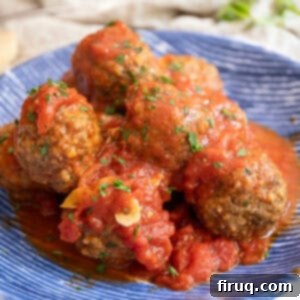
Classic Fried Italian Meatballs
Vincent DelGiudiceEquipment
- 1 large saucepan or heavy-bottomed frying pan (cast iron or stainless steel recommended)
- 1 large pot for simmering sauce (if not using same pan)
- Large mixing bowl
- Tongs
Ingredients
For the Meatballs
- 2 lb ground beef (80/20 for best moisture)
- ⅔ cup breadcrumbs
- 2 large eggs
- ½ cup whole milk
- 2 tablespoons fresh parsley, chopped
- ¼ cup Parmigiano cheese, freshly grated
- 1 tablespoon garlic powder
- 2 tsp kosher salt
- ¼ cup extra virgin olive oil (for frying)
For the Sauce
- 1 28 oz can whole plum tomatoes (or crushed tomatoes)
- 2 cloves fresh garlic, sliced
- 1 tbsp extra virgin olive oil (for sauce)
- 1 handful fresh basil
- 1 teaspoon salt (to taste)
Instructions
- In a large bowl, combine the ground beef, breadcrumbs, eggs, milk, parsley, grated Parmigiano cheese, garlic powder, and kosher salt. Mix thoroughly with your hands until all ingredients are well combined, being careful not to overwork the meat. If the mixture feels a little too wet, add extra breadcrumbs, one tablespoon at a time, until it reaches a slightly tacky consistency. If it’s too dry, add a splash more milk.
- Roll the mixture into meatballs, aiming for about a ¼ cup in size for each. This should yield approximately 20-24 meatballs.
- Heat the ¼ cup of olive oil in a large, heavy-bottomed pan (cast iron or stainless steel) over medium heat until it reaches about half a fingernail’s depth. Once hot, carefully place your meatballs into the pan, ensuring not to overcrowd it. Work in batches if necessary to allow proper browning.
- Fry the meatballs for about 1 minute on each side, turning gently with tongs, until they are evenly browned and have developed a delicious crust all around. At this stage, they don’t need to be cooked through. If you prefer to cook them fully without simmering in sauce, continue frying until they reach an internal temperature of 165°F (74°C). Otherwise, remove the browned meatballs from the pan and set them aside.
- In the same pan (or a separate large pot), add 1 tablespoon of fresh olive oil. Add the sliced garlic and sauté for 1-2 minutes until fragrant and lightly golden, being careful not to burn it. Pour in the 28 oz can of crushed tomatoes (or hand-crush whole plum tomatoes). Stir in the fresh basil and 1 teaspoon of salt. Bring the sauce to a gentle simmer.
- Carefully transfer the browned meatballs to the simmering tomato sauce. Allow them to simmer gently for at least 30 minutes, or for up to 2 hours for maximum tenderness and flavor infusion. The longer they simmer, the softer and more flavorful your meatballs will become. Once cooked to your liking, remove the meatballs from the sauce and serve them warm. Use the rich, meatball-infused sauce from the pot to serve alongside your favorite pasta or other dishes.
Notes
- I prefer to use a cast iron pan or stainless steel pan to fry meatballs if I’m not cooking them in the same pot as the sauce. It is best not to use a non-stick pan because you won’t get a crust on the meatballs. Cast-iron and stainless steel retain heat really well, so all of the meatballs cook evenly and develop a nice brown crust
- I used a ¼ cup of oil but depending on the size of your pan this can differ. You want the oil to be about half a fingernail deep in the pan.
- Usually, I’m making meatballs with Sunday sauce. I simmer them in the sauce for 2-3 hours. The longer you simmer them, the softer they will be.
- Don’t overwork the meatballs. The more you mix together the meat, the denser it will get which will result in hard meatballs.
